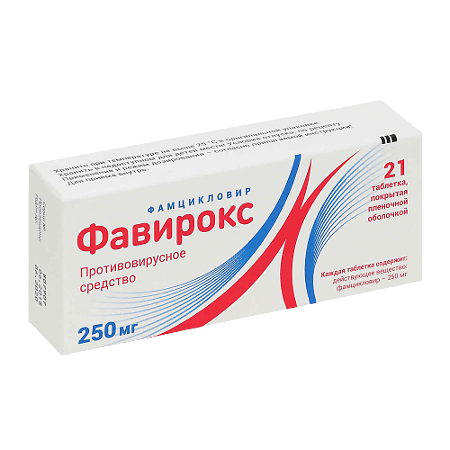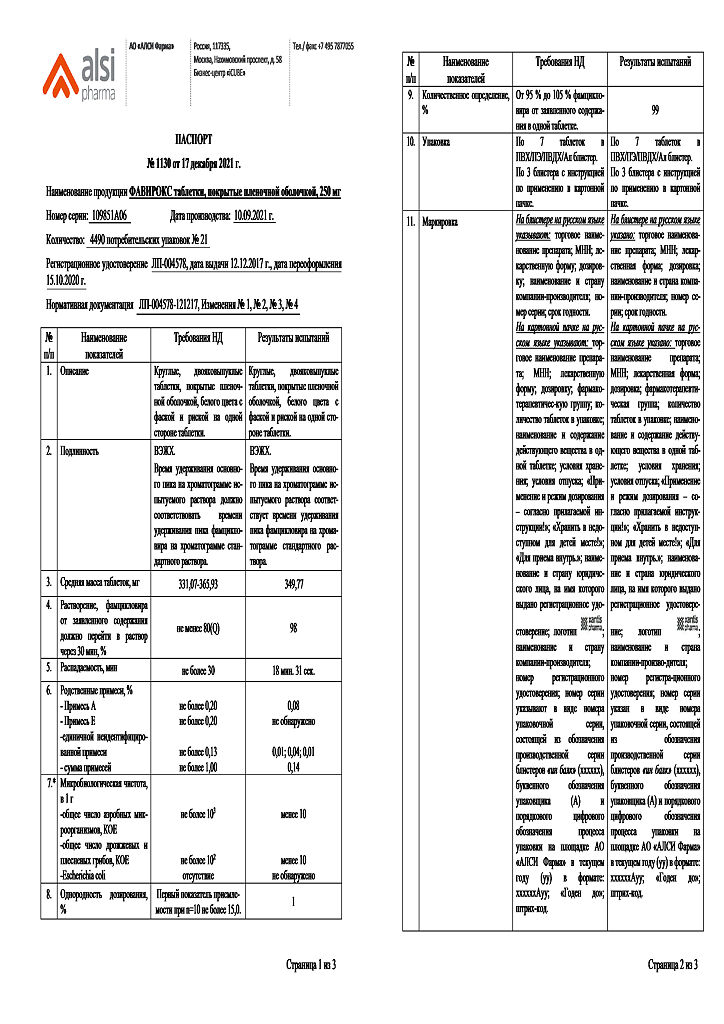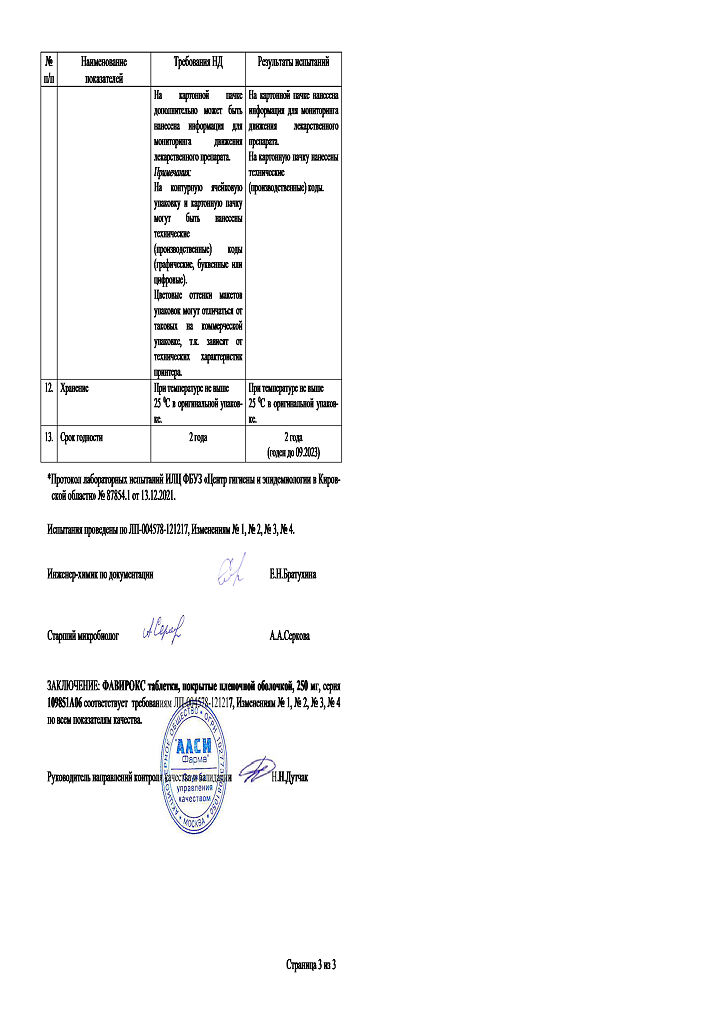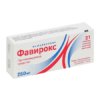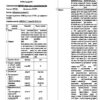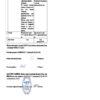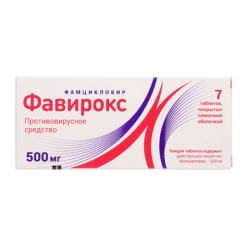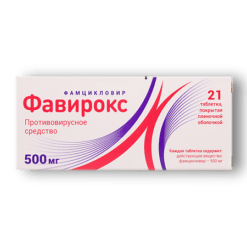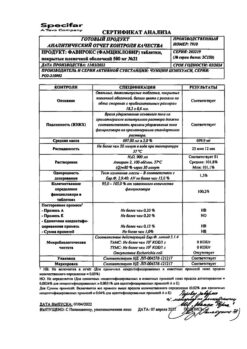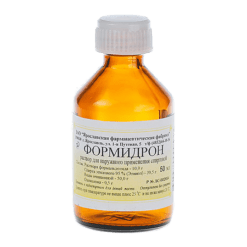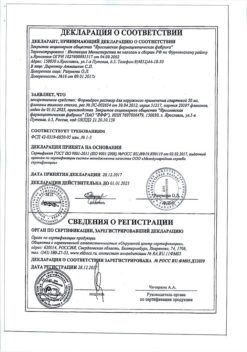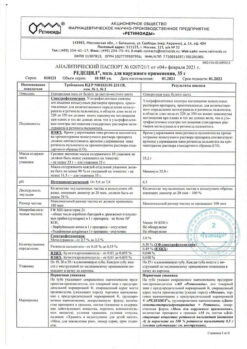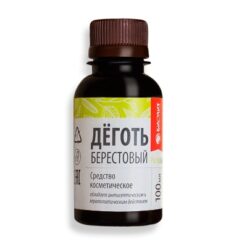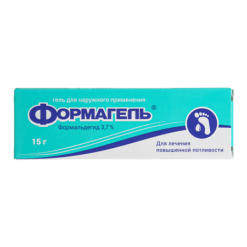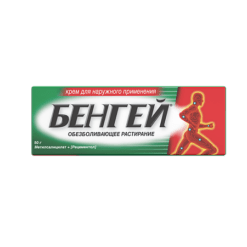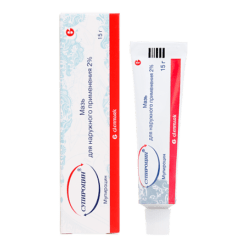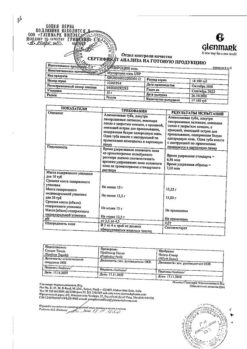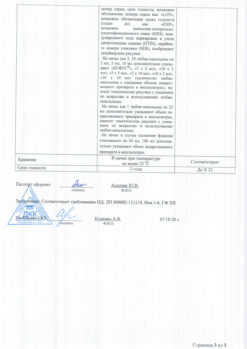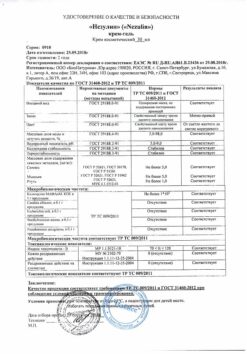No products in the cart.
Favirox, 250 mg 21 pcs
€49.89 €41.58
Description
Herpes zoster (infection caused by VZV):
- to treat herpes zoster including ophthalmoherpes in immunocompetent patients;
- to treat herpes zoster in immunocompromised patients.
Genital herpes (infection caused by HSV):
- treatment of first episode and recurrence of genital herpes in immunocompromised patients;
- treatment of recurrence of genital herpes in immunocompromised patients;
- to prevent exacerbations of genital herpes (suppressive therapy) in immunocompromised and immunocompromised patients.
Labial herpes (infection caused by HSV):
- treatment of relapsed labial herpes in immunocompromised patients;
- treatment of relapsed orolabial herpes in immunocompromised patients.
Indications
Indications
Herpes zoster (infection caused by VZV):
for the treatment of herpes zoster including ophthalmoherpes in immunocompetent patients;
for the treatment of herpes zoster in immunocompromised patients.
Genital herpes (infection caused by HSV):
treatment of the first episode and relapses of genital herpes in immunocompetent patients;
treatment of relapses of genital herpes in immunocompromised patients;
for the prevention of exacerbations of genital herpes (suppressive therapy) in immunocompetent and immunocompromised patients.
Herpes labialis (infection caused by HSV):
treatment of relapses of labial herpes in immunocompetent patients;
treatment of relapses of orolabial herpes in immunocompromised patients.
Special instructions
Special instructions
Treatment should begin immediately after diagnosis.
Genital herpes is a sexually transmitted disease. During relapses, the risk of infection increases. In the presence of clinical manifestations of the disease, even if antiviral treatment is started, patients should avoid sexual intercourse.
During suppressive therapy with antiviral drugs, the frequency of virus isolation decreases markedly, but, nevertheless, the risk of transmission of infection remains. In connection with the above, when treating with the drug during this period, you should follow the rules of safe sexual behavior.
Effect on the ability to drive a car and/or other mechanisms
The drug Favirox is not expected to affect the ability to drive vehicles and/or operate machinery, however, patients who experience dizziness, drowsiness, confusion or other disorders of the central nervous system while using the drug Favirox should refrain from driving vehicles and/or operating machinery during the period of use of the drug.
Active ingredient
Active ingredient
Famciclovir
Composition
Composition
Each 250 mg film-coated tablet contains:
active ingredient:
famciclovir – 250.00 mg;
excipients:
pregelatinized starch – 37.40 mg,
microcrystalline cellulose – 22.00 mg,
croscarmellose sodium – 20.40 mg,
sodium lauryl sulfate – 3.40 mg,
colloidal silicon dioxide anhydrous – 3.40 mg,
stearic acid – 3.40 mg;
film coating:
Opadry white OY-S-28924 (hypromellose-5cP – 3.74 mg, titanium dioxide – 2.04 mg, hypromellose-15cP – 1.24 mg, macrogol-4000 – 0.74 mg, macrogol-6000 – 0.74 mg) – 8.50 mg.
Pregnancy
Pregnancy
In animal studies, the embryotoxic and teratogenic effects of famciclovir and penciclovir were not revealed. In studies of oral administration of famciclovir, penciclovir was excreted in the milk of lactating rats. It is unknown whether penciclovir is excreted in human breast milk.
However, since there is insufficient data on the safety of the use of famciclovir in pregnant and lactating women, its use during pregnancy and breastfeeding is possible only if the benefit of therapy for the mother outweighs the potential risk for the fetus and child.
There is no data requiring special recommendations for patients with preserved reproductive potential.
Famciclovir does not have a significant effect on human sperm morphology or motility. A decrease in fertility was noted in the experimental model in male rats receiving famciclovir at a dose of 500 mg/kg body weight; in female rats, no pronounced decrease in fertility was noted.
Contraindications
Contraindications
Hypersensitivity to famciclovir or any of the components of the drug. Hypersensitivity to penciclovir.
Children under 18 years of age due to the lack of data on efficacy and safety in patients of this age category.
Severe liver dysfunction due to the lack of data on efficacy and safety in patients in this category.
With caution:
Caution should be exercised when treating patients with impaired renal function, for whom dosage adjustment may be required.
No special precautions are required in elderly patients and patients with mild to moderate hepatic impairment.
Side Effects
Side Effects
Clinical studies have shown good tolerability of famciclovir, incl. in patients with reduced immunity. Cases of headache and nausea have been reported, but these events were mild to moderate and occurred with the same frequency in patients receiving placebo. The remaining adverse events (AEs) were identified in clinical practice when using the drug in the post-registration period.
AEs reported during clinical trials in immunocompromised patients were consistent with those observed in immunocompromised patients.
To assess the frequency of adverse reactions, the World Health Organization (WHO) criteria were used: very often (> 1/10); often (from > 1/100, 1/1000, 1/10000, < 1/1000); very rare (< 1/10000), frequency unknown.
Disorders of the blood and lymphatic system: rarely – thrombocytopenia;
Mental disorders: infrequently – confusion (mainly in elderly patients); rarely – hallucinations;
Nervous system disorders: very often – headache, often – dizziness, infrequently – drowsiness (mainly in elderly patients), frequency unknown – convulsions *;
Cardiac disorders: rarely – a feeling of “palpitations”;
Gastrointestinal disorders: often – nausea, vomiting, abdominal pain, diarrhea;
Disorders of the liver and biliary tract: rarely – cholestatic jaundice;
Immune system disorders: frequency unknown – anaphylactic shock*, anaphylactic reaction*;
Disorders of the skin and subcutaneous tissues: often – rash, itching; uncommon – angioedema (swelling of the face, eyelids, periorbital area, pharynx), urticaria; frequency unknown – severe skin reactions* (including erythema multiforme, Steven-Johnson syndrome, Lyell’s syndrome (toxic epidermal necrolysis), allergic vasculitis).
Laboratory and instrumental data: often – abnormal liver function tests
* – AEs that were not observed during clinical trials, identified in post-marketing observations, and also described in the literature. Since information on these AEs was obtained by spontaneous reports and the exact number of patients taking the drug has not been determined, it is not possible to estimate the frequency of occurrence of these reactions, and therefore “frequency unknown” is indicated for these AEs.
If any of the side effects indicated in the instructions get worse, or you notice any other side effects not listed in the instructions, tell your doctor.
Interaction
Interaction
Concomitant use with probenecid may lead to increased plasma concentrations of penciclovir. To prevent the development of toxic reactions, patients receiving Favirox at a dose of 500 mg simultaneously with probenecid should be monitored, taking into account the possibility of reducing the dose of famciclovir.
There were no clinically significant changes in the pharmacokinetic parameters of penciclovir with its single use (at a dose of 500 mg) immediately after taking antacids (magnesium and aluminum hydroxide) or in patients previously treated with allopurinol cimetidine theophylline zidovudine promethazine (multiple doses).
With a single dose of famciclovir (at a dose of 500 mg) together with emtricitabine or zidovudine, no changes in the pharmacokinetic parameters of penciclovir zidovudine metabolite of zidovudine (zidovudine glucuronide) and emtricitabine were detected.
With single and repeated use of famciclovir (at a dose of 500 mg 3 times a day) together with digoxin, no changes in the pharmacokinetic parameters of penciclovir and digoxin were observed.
Considering that the conversion of the inactive metabolite 6-deoxypenciclovir (formed during deacetylation of famciclovir) into penciclovir is catalyzed by the enzyme aldehyde oxidase, it is possible that drug interactions may develop when using the drug Favirox together with drugs that are metabolized with the participation of this enzyme or that inhibit its activity.
When famciclovir was used together with cimetidine and promethazine, which are aldehyde oxidase inhibitors, in vitro, no disruption of the formation of penciclovir from famciclovir was detected. However, when taking famciclovir together with the powerful in vitro aldehyde oxidase inhibitor raloxifene, the formation of penciclovir from famciclovir may be impaired and, as a result, the effectiveness of famciclovir may be reduced. It is necessary to evaluate the clinical effectiveness of antiviral therapy when administered concomitantly with raloxifene.
Considering that famciclovir is a weak inhibitor of aldehydroxydase in vitro, it may influence the pharmacokinetic parameters of drugs metabolized with the participation of this enzyme.
In experimental studies, famciclovir did not have an inducing effect on the cytochrome P450 system and did not inhibit the CYP3A4 enzyme.
Overdose
Overdose
There are limited data on overdose with famciclovir.
Cases of overdose of famciclovir (10.5 g) were described and were not accompanied by clinical manifestations.
Treatment: symptomatic and supportive. Cases of acute renal failure have rarely been reported in patients with renal disease when recommendations for dose reduction of famciclovir are not followed based on renal function. Penciclovir, which is an active metabolite of famciclovir, is eliminated by hemodialysis. Penciclovir plasma concentrations are reduced by 75% after hemodialysis for 4 hours.
Clinical pharmacology
Clinical pharmacology
After oral administration, famciclovir is rapidly converted to penciclovir, which has activity against human herpes viruses, including Varicella Zoster virus (VZV) and Herpex Simplex (HSV) types 1 and 2, as well as Epstein-Barr viruses and cytomegalovirus.
Penciclovir enters virus-infected cells, where, under the action of viral temidine kinase, it is quickly converted into monophosphate, which in turn turns into triphosphate. Penciclovir triphosphate inhibits the replication of viral DNA (deoxyribonucleic acid).
The intracellular half-life of penciclovir triphosphate for cell cultures infected with HSV 1 is 10 hours, HSV 2 – 20 hours; VZV – 7 hours.
The concentration of penciclovir triphosphate in uninfected cells does not exceed the minimum detectable level, therefore, at therapeutic concentrations, penciclovir has no effect on uninfected cells.
As with acyclovir, resistance to penciclovir is most often associated with mutations in the viral thymidine kinase gene, leading to deficiency or impairment of the substrate specificity of the enzyme. Changes in the DNA polymerase gene are much less common.
The use of famciclovir for the treatment of herpes zoster (caused by VZV) in immunocompetent patients and patients with reduced immunity has been noted to accelerate healing of the skin and mucous membranes. Famciclovir is effective in treating various manifestations of ophthalmic herpes caused by VZV. Famciclovir significantly reduces the severity and duration of postherpetic neuralgia in patients with herpes zoster.
One-day treatment with famciclovir in immunocompetent patients at a dose of 1500 mg 1 time per day or 750 mg 2 times per day promotes rapid resolution of the manifestations of recurrent labial herpes (caused by HSV).
The use of the drug in immunocompetent patients at a dose of 1000 mg 2 times a day for 1 day, 125 mg 2 times a day for 5 days or 500 mg 2 times a day for 3 days accelerates the healing of the skin and mucous membranes in case of relapse of genital herpes (caused by HSV).
Famciclovir at a dose of 500 mg 2 times a day for 7 days is effective in the treatment of various manifestations of herpes zoster in patients with reduced immunity due to infection with the human immunodeficiency virus (HIV). In HIV-infected patients, the drug at a dose of 500 mg 2 times a day for 7 days accelerates the healing of the skin and mucous membranes during relapse of genital herpes, and also reduces the number of days of HSV shedding (both with and without clinical manifestations). The use of famciclovir in patients with compromised immunity due to other reasons has not been studied.
The effectiveness of one-day administration of famciclovir at a dose of 1000 mg 2 times a day for the treatment of recurrent genital herpes in immunocompetent black patients did not exceed that of placebo. The safety profile of one-day administration of the drug at a dose of 1000 mg 2 times a day in this category of patients was similar to that previously established.
Recommendations for use
Recommendations for use
The drug should be taken orally, regardless of food intake, without chewing, with water. Treatment with the drug should begin as early as possible, immediately after the first symptoms of the disease appear (tingling, itching and burning).
VZV (herpes zoster) infection, including ophthalmic herpes in immunocompetent patients:
The recommended dose is 500 mg 3 times a day for 7 days.
VZV (herpes zoster) infection in immunocompromised patients:
The recommended dose is 500 mg 3 times a day for 10 days.
HSV infection (herpes labialis or genital herpes) in immunocompetent patients:
For the first episode of genital herpes, the recommended dose is 250 mg 3 times a day for 5 days;
For relapses of genital herpes, 1000 mg is prescribed 2 times a day for 1 day or 125 mg 2 times a day for 5 days or 500 mg once, followed by 3 doses of 250 mg every 12 hours.
For relapses of labial herpes – 1500 mg once for 1 day or 750 mg 2 times a day for 1 day.
HSV infection (orolabial or genital herpes) in immunocompromised patients:
The recommended dose is 500 mg 2 times a day for 7 days.
To prevent exacerbations of genital herpes (suppressive therapy), use 250 mg 2 times a day. The duration of therapy depends on the severity of the disease. Periodic assessment of possible changes in the course of the disease after 12 months is recommended. In HIV-infected patients, the effective dose is 500 mg 2 times a day.
Patients aged ≥65 years.
In elderly patients with normal renal function, no adjustment of the famciclovir dosage regimen is required.
Patients with impaired renal function.
In patients with impaired renal function, a decrease in the clearance of penciclovir is observed. Recommendations for adjusting the dosage regimen in immunocompetent patients with impaired renal function depending on creatinine clearance are presented in Table 1.
Recommendations for adjusting the dosage regimen in immunocompromised patients with impaired renal function depending on creatinine clearance are presented in Table 2.
Table 1. Dosage adjustments in immunocompetent patients with impaired renal function
VZV (herpes zoster) infection
Dosage regimen
Creatinine clearance
Adjusted dosage regimen
500 mg 3 times a day for 7 days
≥60
500 mg 3 times a day for 7 days
40–59
500 mg 2 times a day for 7 days
20–39
500 mg 1 time per day for 7 days
< 20
250 mg once a day for 7 days
Patients on hemodialysis or undergoing hemodialysis
250 mg after each dialysis session for 7 days
HSV infection
Genital herpes, first episode
250 mg 3 times a day for 5 days
≥40
250 mg 3 times a day for 5 days
20–39
250 mg 2 times a day for 5 days
< 20
250 mg 1 time per day for 5 days
Patients on hemodialysis or undergoing hemodialysis
250 mg after each dialysis session for 5 days
For relapses of genital herpes
1000 mg 2 times a day for 1 day
≥60
1000 mg 2 times a day for 1 day
40–59
500 mg 2 times a day for 1 day
20–39
500 mg once
< 20
250 mg once
Patients on hemodialysis or undergoing hemodialysis
250 mg once after a dialysis session
125 mg 2 times a day for 5 days
≥20
125 mg 2 times a day for 5 days
< 20
125 mg 1 time per day for 5 days
Patients on hemodialysis or undergoing hemodialysis
125 mg after each dialysis session for 5 days
500 mg once followed by 3 doses of 250 mg every 12 hours
≥40
500 mg once followed by 3 doses of 250 mg every 12 hours
20–39
250 mg once followed by 3 doses of 250 mg every 12 hours
< 20
250 mg once followed by 250 mg the next day
Patients on hemodialysis or undergoing hemodialysis
250 mg once after a dialysis session
To prevent exacerbations of genital herpes (suppressive therapy)
250 mg 2 times a day
≥40
250 mg 2 times a day
20–39
125 mg 2 times a day
< 20
125 mg 1 time per day
Patients on hemodialysis or undergoing hemodialysis
125 mg after each dialysis session
Labial herpes
1500 mg once
≥60
1500 mg once
40–59
750 mg once
20–39
500 mg once
< 20
250 mg once
Patients on hemodialysis or undergoing hemodialysis
250 mg once after a dialysis session
750 mg 2 times a day
≥60
750 mg 2 times a day for 1 day
40–59
750 mg once
20–39
500 mg once
< 20
250 mg once
Patients on hemodialysis or undergoing hemodialysis
250 mg once after a dialysis session
Table 2. Correction of the dosage regimen in immunocompromised patients with impaired renal function
VZV (herpes zoster) infection
Dosage regimen
Creatinine clearance
Adjusted dosage regimen
500 mg 3 times a day for 10 days
≥60
500 mg 3 times a day for 10 days
40–59
500 mg 2 times a day for 10 days
20–39
500 mg 1 time per day for 10 days
< 20
250 mg once a day for 10 days
Patients on hemodialysis or undergoing hemodialysis
250 mg after each dialysis session for 10 days
HSV infection (orolabial or genital herpes)
500 mg 2 times a day for 7 days
≥40
500 mg 2 times a day for 7 days
20–39
500 mg 1 time per day for 7 days
< 20
250 mg once a day for 7 days
Patients on hemodialysis or undergoing hemodialysis
250 mg after each dialysis session for 7 days
Patients with renal failure who are on hemodialysis or undergoing hemodialysis.
Since the plasma concentration of penciclovir decreases by 75% after 4-hour hemodialysis, famciclovir should be taken immediately after the hemodialysis procedure. The recommended dose adjustment regimen is described in Tables 1 and 2.
Patients with impaired liver function.
For patients with mild to moderate liver dysfunction, no dose adjustment is required. There is no experience with the use of the drug in patients with severe liver dysfunction.
Negroid patients.
The effectiveness of one-day administration of famciclovir at a dose of 1000 mg 2 times a day for the treatment of recurrent genital herpes in immunocompetent black patients did not exceed that of placebo. The clinical significance of dosing regimens for the treatment of both recurrent genital herpes (within 2 or 5 days) and other infections caused by VZV and HSV is unknown.
Storage conditions
Storage conditions
Store at a temperature not exceeding 25 °C in the original packaging.
Shelf life
Shelf life
2 years
Manufacturer
Manufacturer
PharmaPass S.A., Greece
Additional information
| Shelf life | 2 years |
|---|---|
| Conditions of storage | Store at a temperature not exceeding 25 ° C in the original package. |
| Manufacturer | Specifar S.A., Greece |
| Medication form | pills |
| Brand | Specifar S.A. |
Other forms…
Related products
Buy Favirox, 250 mg 21 pcs with delivery to USA, UK, Europe and over 120 other countries.

